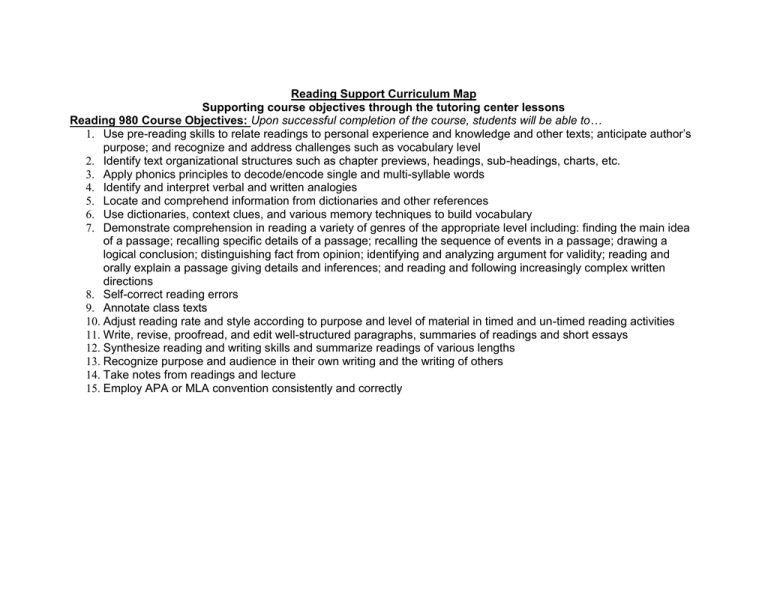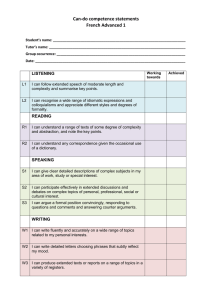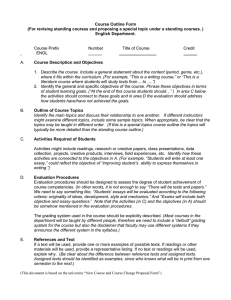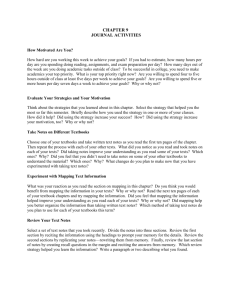Reading Support Curriculum Map Reading 980 Course Objectives: …
advertisement

Reading Support Curriculum Map Supporting course objectives through the tutoring center lessons Reading 980 Course Objectives: Upon successful completion of the course, students will be able to… 1. Use pre-reading skills to relate readings to personal experience and knowledge and other texts; anticipate author’s purpose; and recognize and address challenges such as vocabulary level 2. Identify text organizational structures such as chapter previews, headings, sub-headings, charts, etc. 3. Apply phonics principles to decode/encode single and multi-syllable words 4. Identify and interpret verbal and written analogies 5. Locate and comprehend information from dictionaries and other references 6. Use dictionaries, context clues, and various memory techniques to build vocabulary 7. Demonstrate comprehension in reading a variety of genres of the appropriate level including: finding the main idea of a passage; recalling specific details of a passage; recalling the sequence of events in a passage; drawing a logical conclusion; distinguishing fact from opinion; identifying and analyzing argument for validity; reading and orally explain a passage giving details and inferences; and reading and following increasingly complex written directions 8. Self-correct reading errors 9. Annotate class texts 10. Adjust reading rate and style according to purpose and level of material in timed and un-timed reading activities 11. Write, revise, proofread, and edit well-structured paragraphs, summaries of readings and short essays 12. Synthesize reading and writing skills and summarize readings of various lengths 13. Recognize purpose and audience in their own writing and the writing of others 14. Take notes from readings and lecture 15. Employ APA or MLA convention consistently and correctly Session 1 2 COURSE OBJECTIVES 1. Use pre-reading skills to relate readings to personal experience and knowledge and other texts; anticipate author’s purpose; and recognize and address challenges such as vocabulary level 10. Adjust reading rate and style according to purpose and level of material in timed and un-timed reading activities 3. Apply phonics principles to decode/encode single and multi-syllable words 8. Self-correct reading errors ACTIVITY DESCRIPTION BY LEVEL 1. Directed instruction on how to use pre-reading strategies. 2. Guided instruction on existing skills in prereading strategies and adding new ones. 3. Use pre-reading strategies to predict information about a text and test to see if predictions are true. Refine pre-reading strategies as needed. MATERIALS Article “Fight for First Year in College” by Steve Gladis PPT Session 1 Webs and graphic organizers as needed 1. Students will review and utilize pre-reading strategies with a chapter of a textbook. Students will identify important text features. Students will use text features to identify important vocabulary terms in the chapter. Tutors will introduce students to tools such as glossaries, indexes, and context clues in order to determine meanings of key words. Students will make flashcards or take notes on words. Students will practice reading key words aloud and in context of chapter. 2. Guided pre-reading strategies will be applied to a chapter of a textbook. Students will identify difficult and important words in the text. Tutors will guide students to utilize tools to determine correct meaning and pronunciation of words and practice reading aloud should show improvement of fluency. 3. Pre-reading strategies will be applied to a textbook chapter. Students will then select one page to read aloud. Students should demonstrate to tutors that they can identify difficult words, selfcorrect mispronunciations, utilize tools such as glossaries and indexes to better understand Verbal examples of reading texts aloud from a variety of genres. Student textbooks. Student assignments. 3 4 9. Annotate class texts 5. Locate and comprehend information from dictionaries and other references 6. Use dictionaries, context clues, and various memory techniques to build vocabulary unknown words, and read a page of text with appropriate rate and style according to genre. 1. Students will identify and discuss types of texts and their purposes. Students will practice a set of annotating strategies as modeled and guided by a tutor using the sample text. Students will be taught by tutor reasons that annotating can help in studying and text comprehension. Students will practice annotating strategies with sample text and their own textbooks, an article from class. 2. Students will brainstorm reasons to annotate a text and methods for annotating a text. Students will explore at least three new strategies in addition to the ones they use. Students will practice annotating strategies with their own textbooks, an article from class, or a sample text provided by tutor. 3. Students will demonstrate annotating strategies with their own textbooks, an article from class, or a sample text provided by tutor. Students will then lead a discussion with classmates and/or tutor about how these strategies help them understand the overall meaning of the text. Students will refine or add at least one strategy for annotation to what they are already using. 1. Students will use a sample text to identify unknown words. Students will be taught strategies for identifying clues within the text that help decipher meaning. Students will be guided through using dictionaries and reference materials for words that are more difficult. 2. Students will practice finding and discussing the meanings of unknown words in a sample text. Students will discuss strategies that they use for deciphering words and their meanings and tutors will give additional strategies. Students will practice determining which definitions and details from Power Point on annotating texts. Article “Text Anxiety” Student textbooks, articles for class, and sample articles. Sample texts could include the EMS Guidebook or Hotel on the Corner of Bitter and Sweet. Session 4 handout Session 4 ppt Hotel on the corner of bitter and sweet book review. Highlighter, pencil, etc. Dictionary or web access reference materials are relevant for their texts. 3. Students will discuss strategies that they use for deciphering words and their meanings. Students will refine any skills in utilizing context clues, dictionaries, and reference materials that are in need of improvement as determined by discussion with the tutor. Students will demonstrate the ability to determine which definitions and details from reference materials are relevant for their texts. 5 7. Demonstrate comprehension in reading a variety of genres of the appropriate level including: finding the main idea of a passage; recalling specific details of a passage; recalling the sequence of events in a passage; drawing a logical conclusion; distinguishing fact from opinion; identifying and analyzing argument for validity; reading and orally explain a passage giving details and inferences; and reading and following increasingly complex written directions 1. Students will use their own textbooks or readings from class to develop and demonstrate comprehension skills by using a graphic organizer or Cornell notes to record main ideas, details, sequence of events, facts and opinions. Students will also discuss and record conclusions about the text using sentence frames and analyze the validity of an argument by answering questions. Students will practice reading a summary of the text aloud. 2. Students will us their own textbooks or readings from class to develop and demonstrate comprehension skills by using a graphic organizer or Cornell notes to record main ideas, details, sequence of events, facts and opinions. Students will also discuss and record conclusions about the text and validity of the author’s argument. Students practice reading a summary of the text aloud. 3. Students will use their own textbooks or readings from class to develop and demonstrate comprehension skills by using notes, annotations, or a graphic organizer to describe main ideas, details, sequence of events, facts and opinions. Students will also describe conclusions drawn from the text and validity of the author’s argument by presenting possible opposing arguments and conclusions. Students will summarize all key points o o o o Session 5 handout Session 5 graphic organizers Cornell notes template Sentence frames of the text aloud. 6 7 8 13. Recognize purpose and audience in their own writing and the writing of others 12. Synthesize reading and writing skills and summarize readings of various lengths 11. Write, revise, proofread, and edit wellstructured paragraphs, summaries of readings and short essays 15. Employ APA or MLA convention consistently and correctly 1. Students will review what purpose is and what audience is with tutor. Tutor will review persuasive, entertaining, and informative purposes with sample texts. Students will use pre-reading, annotating, and summarizing strategies to determine purpose for a selected text. 2. Students will review the three kinds of purpose with tutors and practice categorizing sample texts as persuasive, entertaining, and informative. Students will annotate a selected text and identify evidence for their decision about the purpose. 3. Students will select three texts from a list of articles on college topics. Students will categorize texts as entertaining, persuasive, or informative. Students will annotate a text and identify evidence to support claim. Students will also give their own examples of topics that would fall into each category. 1. Students will select a text from one of their classes and use previous strategies to identify main ideas, important details, and key vocabulary. Students will be given sentence frames to construct a summary and read the summary aloud several times. 1. Students will bring a sample of writing from class or a writing assignment they must complete for class to this session. After the assignment is completed, students will be asked to read the assignment and identify areas that they believe need improvement. Tutor will guide students through a step-by-step editing and revising process using a checklist. Finally, students will read their assignments aloud several times. Students will complete an appropriate APA or MLA citation. 2. Students will bring a sample of writing from class o 10 Best Careers for College Graduates o A Diary of a College Student o Financial Aid Myths and Realities o Coping with College Series: Get Your Life in Order this Semester o College and Drinking o Dating on a College Budget o 7 Major Scholarship Scams o o o o https://owl.english.purdue.edu/ http://www.citefast.com/ http://www.literatelearner.com/6traits Session 8 Handout 9 9. Annotate class texts 14. Take notes from readings and lecture 10 or a writing assignment they must complete for class to this session. After the assignment is completed, the tutor will provide a step-by-step editing and revising checklist and review at least 3 areas that the student feels are weakest. Finally, students will read their assignments aloud several times as needed. Students will complete an appropriate APA or MLA citation. 3. Students will bring a sample of writing from class or a writing assignment they must complete for class to this session. Students will be given an editing and revising checklist. After they review their own assignment, students will select one area that they feel is weakest to focus on with the tutor. Tutor will help student find ways to revise that aspect of the assignment. Student will revise assignment and reread aloud in order to check for additional areas that need revision. This process will be repeated as needed. Students will use course materials and demonstrate several skills learned in previous sessions by participating in a group tutorial using texts and notes from class. Review Project Students will re-evaluate themselves on all course evaluations and compare growth from the initial rating for each tutoring session. Students will then select two course objectives that they believe will help them in their future college or career and respond in a written reflection. Session 9 PPT Class textbook Lecture notes Whiteboard & dry erase markers




